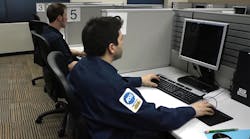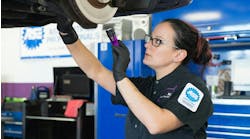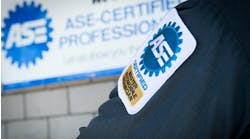Since 1972, the National Institute for Automotive Service Excellence, or ASE, has been working to improve the quality of vehicle repair and service by testing and certifying medium/heavy-duty truck professionals. ASE has become known as the pre-eminent independent non-profit organization working to uphold and promote high standards of vehicle service and repair.
Today, more than a quarter of a million individuals who currently hold ASE certifications work in every segment of the transportation industry, from automobile and medium/heavy-duty truck to transit and school bus, collision repair, parts, military, and more. The path to ASE certification begins with one or more of 57 different tests. After passing at least one exam and providing proof of two years of relevant work experience, the individual becomes ASE Certified. To remain certified, the professional must be retested every five years.
The tests are no cinch to pass; in fact, usually only two out of every three test takers pass on their first attempt. The exams stress knowledge of real-world job-related skills with each test question developed through a strict writing and validating process. ASE test questions are written in workshops by experts in the subject matter of each specific test. The test development teams represent a national cross-section of the motor vehicle service industry, including current technicians, training reps from auto and truck manufacturers and aftermarket companies, customer service professionals, and educators.
The following is a step-by-step look at exactly how the ASE tests are developed.
- Test questions are developed at test-writing workshops, which typically include 10-20 working service professionals. Separate workshops are conducted for each ASE certification test.
- At each workshop, the participants review and modify the list of tasks needed to successfully perform each particular job category (such as suspension and steering systems).
- Questions are then written by the industry experts to correspond to these job tasks. The diagnostic and repair scenarios are updated to reflect the most current and relevant technology and systems. This ensures that all test questions focus on need-to-know topics.
- Trick questions and manufacturer-specific questions are not acceptable. Each question is reviewed by the entire workshop for clarity and technical accuracy to ensure there is only one right answer and three incorrect answers.
- Questions that are accepted by the panel are included as non-scored pre-test questions and placed in live ASE tests to gauge performance. Since test-takers do not know which questions count, they do their best to answer every question correctly, and accurate statistics are collected.
- Based on how well a question performs in pre-test, it may become a live test question or be reconsidered in a future workshop. Only those questions with an appropriate level of difficulty and strong ability to identify more-knowledgeable technicians make the cut. At this point, every question used for score in an ASE test has been written and approved by a panel of industry experts and validated by hundreds or thousands of working technicians.
- Even after a question passes pre-testing, ASE continues to monitor it. Each question is tracked for proper performance every time it is used in a test.
- When a question becomes technically outdated, it is removed from the pool of live test questions.
Most technicians and fleet shop owners would agree that each year, trucks are getting more complex and that repair technology and diagnostic tools are constantly changing. While this presents a challenge to the truck service and repair industry, it also presents a challenge to fleet management searching for competent and knowledgeable professionals to care for their vehicle fleet. By virtue of ASE’s unique and rigorous test development process, technicians can trust that the ASE tests fairly assess their knowledge, and employers and fleet owners can be assured that ASE Certified medium/heavy-duty truck technicians are up to the task.
George Arrants is the vice president for ASE Education Foundation. Arrants works with instructors and administrators to develop partnerships with local businesses and industries through program advisory committees. He is the past chair of the Technology and Maintenance Council’s TMCSuperTech, the National Technician Skills Competition, and TMCFutureTech, the National Student Technician Competition. His entire career has been in the automotive service and education industries.




